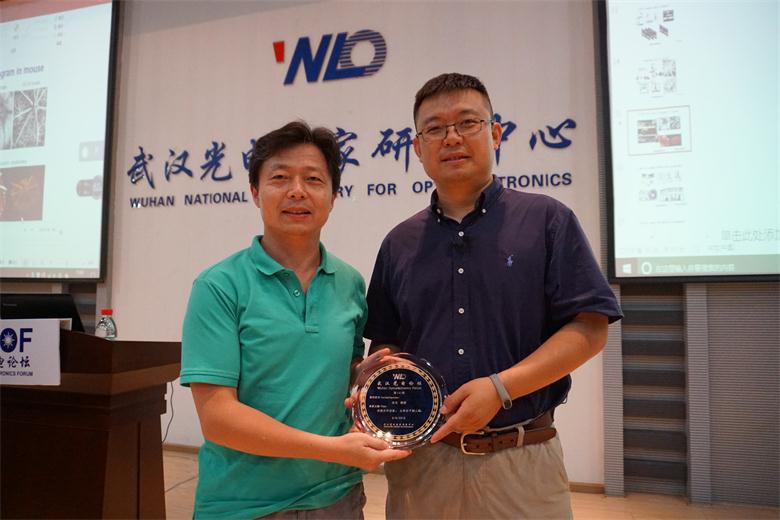WUHAN, China (June 8, 2018) - Wuhan Optoelectronics Forum No. 141 was successfully held in Auditorium A101 at Wuhan National Laboratory for Optoelectronics (WNLO) in the morning of June 8. Prof. Hao F. Zhang from Northwestern University delivered an exciting talk entitled Functional Optical Imaging, From Single Molecules to Human Eyes. Prof. ZhenLi Huang, from Britton Chance Center for Biomedical Photonics chaired the forum. Prof. ShaoQun Zeng, awarded Prof. Hao F. Zhang the forum medal.
My lab focuses on two optical imaging technologies, optical coherence tomography (OCT) and photon localization microscopy, to fill the gaps in both clinical diagnoses and fundamental biomedical investigations. To enable OCT to extract physiological and pathological information beyond high-quality anatomical imaging, we developed visible-light OCT or vis-OCT. Operating within the visible-light spectral range, vis-OCT has demonstrated great potential in ultra-high resolution imaging, angiogram, oxygen metabolic imaging, and ultrastructural pathological sensing. We are applying vis-OCT to investigate several blinding diseases (diabetic retinopathy, retinal vein occultation, macular degeneration, and glaucoma) and brain disorders (ischemic strokes, brain tumors). In our super-resolution imaging work, we developed spectroscopic photon localization microscopy(SPLM). Traditional photon localization microscopy analyzes the spatial distributions of photons emitted stochastically by individual molecules to reconstruct super-resolution optical images. SPLM further captures the inherent spectroscopic signatures of these photons. Through molecular discrimination and regression, SPLM can reach the spatial resolution of 10 nm or greater without significantly increasing the total number of image frames. Using SPLM, we demonstrated simultaneous multi-molecular super-resolution imaging, where the number of fluorescence labels can have largely overlapping emission spectra with only minute differences. We further investigated intrinsic stochastic fluorescence emission from unstained nucleotides, seeking label-free super-resolution imaging.
Hao F. Zhang is a Professor of Biomedical Engineering at Northwestern University. He received his Bachelor and Master degrees from Shanghai Jiao Tong University(Shanghai, China) in 1997 and 2000, respectively, and his Ph.D. degree from Texas A&M University (College Station, Texas) in 2006. From 2006 to 2007, he was a postdoctoral fellow at Washington University in St. Louis. He and colleagues reported the first demonstration of photoacoustic microscopy (Nature Biotechnology 2006, Nature Protocols 2007, PNAS 2010), the first spectroscopic super-resolution imaging (Nature Communications 2016), and the first observation of intrinsic stochastic fluorescence emission from DNA (PNAS 2016). He received the NSF CAREER award and NIH Director’s Challenge Award in 2010, the NIH IMPACT award in 2015, the SPIE Translational Research Award in 2016, and the US National Academy of Sciences Cozzarelli Prize in 2017. His research interests include optical coherence tomography, super-resolution imaging, single molecule imaging, vision science, and cancers. He is an associate editor of Biomedical Optics Express and is a chartered member of the NIH Neuroscience and Ophthalmic Imaging Technologies (NOIT) study section. In 2015, he co-founded Opticent Health to commercialize optical coherence tomography technologies developed in his lab.

